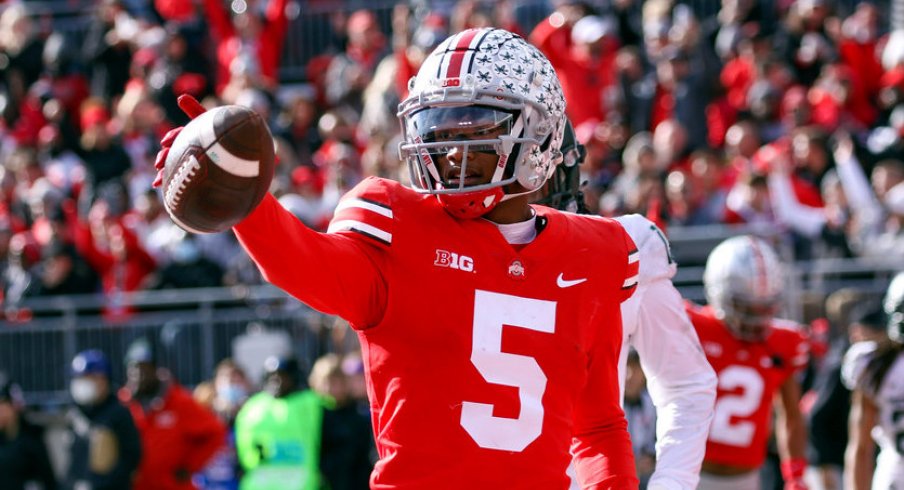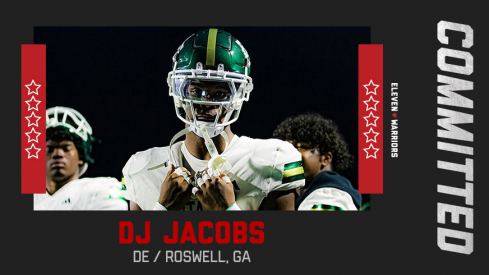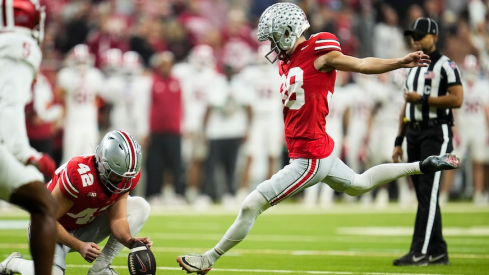Mel Tucker still deserves a lot of credit.
Coming off a woeful 2-5 season and turning over nearly half the roster in the offseason, Vegas pegged Tucker's Spartans at a measly 4.5 wins this fall. Despite getting blown out in Ohio Stadium this past Saturday, it's still fair to say his team has beaten the odds.
Perhaps even more impressively, Tucker has his team sitting at 9-2 and just outside the AP top 10 despite his team failing to live up to his calling card of playing tough pass defense.
Everyone knew Michigan State would have its hands full with the OSU passing game last weekend. Already ranked last in the nation in stopping opponents through the air, the Spartans now sit even further from the 129th-ranked team in the category after C.J. Stroud and the trio of all-everything receivers tore through the MSU secondary.
"From a coaching standpoint, there weren't any surprises out there in terms of what we saw," Tucker said of the Buckeyes after the game. "It was just a matter of they out-executed us and they won some one-on-ones. A lot of times it does come down to one-on-one matchups and they won those."
While Tucker leaves the actual play-calling duties to his defensive coordinator, Scottie Hazelton, the head coach's career influences were clearly on display as his team attempted to slow down the nation's best offense. On early downs, we saw some versions of the Cover 3-match (Rip/Liz) defense made famous by his mentor, Nick Saban, as the Spartans tried to bring an additional body into the box to stop the run in the form of a safety.
Additionally, in an effort to disrupt the Buckeyes early, the Spartans unleashed a variety of 6-man pressures early on in hopes of either disrupting the run game or forcing Stroud to get the ball out quickly before his receivers could get downfield. However, Day and his staff seemed well-prepared for such an approach, manipulating the 3-deep, 2-under "HOT" coverage employed behind the blitz.
For example, on the game's first drive the Buckeyes sent Garrett Wilson across the formation on what looked like Jet motion as if to take a handoff right after the snap. With two defenders already coming on a blitz through the interior, the entire secondary had to rotate to the wide side of the field to account for Wilson taking the ball around that edge.
But that approach left no one home on the backside, allowing TreVeyon Henderson to explode for a big gain on a simple mid-zone run after the Buckeye offensive line picked up the blitz.
As the Buckeyes marched down the field on that drive, Hazelton was forced to dial up the preferred pass defense of Saban acolytes - a two-deep Quarters coverage full of checks and variations that is more of a system than a single play, known simply as Cover 7. When implemented properly, the coverage can morph into whatever is needed to stop the offense's alignment, mixing elements of man and zone coverage on the same play.
But the system can take years to master for both players and coaches, and it's clear that the Spartans have yet to do so. When Chris Olave scored the first of six touchdown passes to come out of Stroud's hand that day, he did so by splitting the two deep safeties as they scrambled to take away multiple deep routes meant to attack them at once.
The boundary safety knew he was responsible for Olave as the speedy receiver released up the seam, but he clearly expected his fellow safety to provide help over the middle. However, when Garrett Wilson released upfield as the only receiver to the opposite side, the field safety got caught looking at Wilson to make sure he wasn't needed to help on that route.
Meanwhile, an underneath crossing route from Jaxon Smith-Njigba created a high/low stretch on the defense, holding the linebackers underneath and leaving Olave alone to split the safeties. By the time the field safety realized Wilson was never breaking back to the post, it was already too late.
On the very next drive, Day would call for a variation of the same concept once more, and with the same result.
This time, the Spartans employed their version of Cover 3 weak in which the backside safety rolled down to play an underneath zone and help against the run. However, when Smith-Njigba and tight end Cade Stover ran the dual crossing routes to occupy the lone, deep safety, it left the weak side cornerback one-on-one with Wilson outside, meaning Stroud simply had to put the ball on target to come away with six points.
The Buckeyes hadn't simply stretched the field vertically, though. Mixed in between those deep balls was a variety of pre-snap "access" RPOs that gave Stroud the option to throw a quick pass outside based on the defense's alignment.
As we've seen in recent weeks, that often meant throwing quick screens to his talented receivers. By stacking one behind the other, it created the space for the front receiver to block the corner while buying enough time to complete a bubble screen before the second defender arrived.
But less obvious is what happened at the bottom of the screen in the example above. Not only did Stroud have a pre-snap option to throw, but he had a post-snap option in the form of his tight end as well.
The defensive end was left unblocked on the play as Ruckert released into the flat, ready to catch a short pass should the end have crashed down to play the handoff. Such a concept may have been called as much to beat one team from the mitten state as the other (more on that in a bit).
On Saturday, the Buckeyes appeared to empty the playbook once the game was in hand, seeming to show every formation, personnel group, and RPO combination they could think of, despite already holding a commanding lead on the Spartans.
One such example was the 12 personnel empty formation, in which the back and both tight ends line up in a tight bunch to one side while two receivers split out the opposite way. If the defense properly respects the alignment, Stroud simply signaled for the trio to come back and line up in a traditional look. But if the defense was sending a blitz on the play and didn't have the requisite bodies outside, he'd fire a quick screen instead.
Not only did this expose the tendencies of the Spartan defense, who bet on sending a 6-man blitz when all else failed, but it plays into what the Buckeyes can expect to see in their regular-season finale. Ohio State's biggest rivals feature a defense that ranks in the top 10 nationally in total yards allowed per game, thanks to an aggressive scheme built around disguising pressure.
Few teams in the Big Ten have found success against them this fall, but one of the few that did was Nebraska's option-heavy attack. While Stroud certainly won't become a threat to run the ball anytime soon, he will undoubtedly look to exploit the run-first mentality of the Wolverine linebackers, just as the Cornhuskers did by attaching a tight end pop pass to an inside run.
But the Wolverines' biggest defensive threat comes on the edges, as defensive ends Aidan Hutchinson and David Ojabo have wreaked havoc on opposing blockers all season. Incapable of blocking the duo regularly, the Cornhuskers decided to isolate them throughout their contest, resulting in an average gain of 7.18 yards per play - the most surrendered by the maize and blue all season.
Not only did Nebraska rely on the tight end as a receiving threat in the RPO game, but they often lined up in the pistol and used bootlegs to keep the ends from rushing straight upfield.
This boot action not only helped when the Huskers kept on a play fake, but it negated Hutchinson's aggressiveness against the run. Watch as he hesitates to step down on the pistol handoff, despite never getting blocked, allowing the back to pick up five yards before ever getting touched.
While Stroud is not quite as dangerous on a rollout as his predecessor, Justin Fields, he looked plenty comfortable when asked to do so in recent weeks, finding crossers like Ruckert and Smith-Njigba while negating the pass rush.
The Wolverine defense requires a great deal of communication, due to its complexity, and by showing so many different things on Saturday, the Buckeyes only added more to this week's game plan. How, exactly, Ryan Day and co. plan to attack in Ann Arbor remains to be seen, but as we saw this past Saturday, they have plenty of options.
"We've seen these guys on film jump out on people early," Tucker added. "We knew we couldn't allow that to happen because they can score quickly. They get up on you and get the crowd into it and then it's a wrap."



